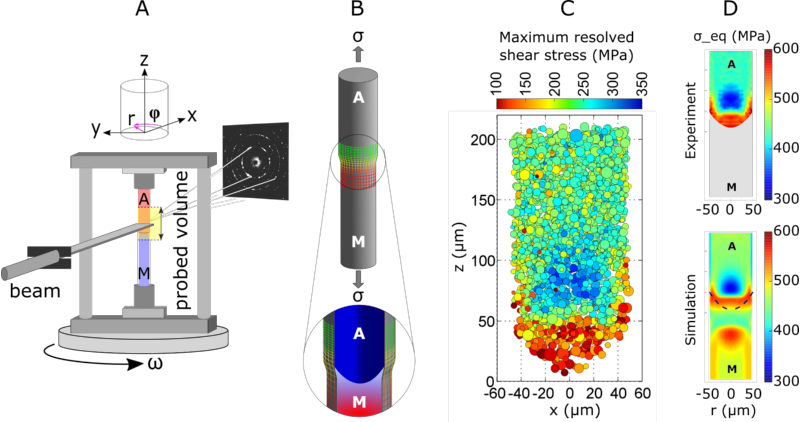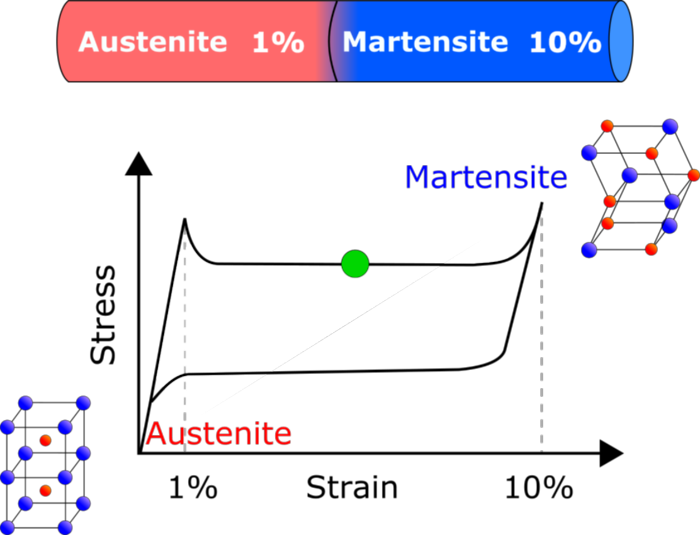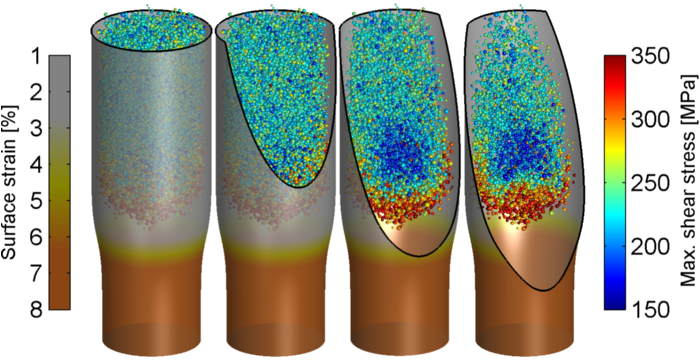
Scientists from the Czech Academy of Sciences explore the nature of the localized deformation
Scientists from the Czech Academy of Sciences explore the nature of the localized deformation
Fri Aug 05 10:14:20 CEST 2016

A team of researchers from the Institute of Physics and Institute of Thermomechanics of the Czech Academy of Sciences (CAS) recently published a study in the Science journal, which for the first time explained the mesomechanics of localized deformation in tensioned wire. Unlike other materials which deform homogenously, when NiTi wire is being stretched inelastic deformation proceeds via propagation of macroscopic transformation fronts separating transformed and untransformed regions. How and why the localized deformation happens has always attracted the attention of mechanical engineers as well as theoreticians involved in modelling of material deformation. The team from the CAS managed to obtain new information on the topology of buried internal interface surrounded by internal stress fields in the tensioned wire. To achieve that they combined 3D X-ray diffraction method with measurement of surface strains by digital image correlation and finite element simulation of localized deformation by SMA model.
More information can be found on the website Special Topics of the Department of Functional Materials - http://ofm.fzu.cz/.
Polycrystalline solids exposed to external loads usually deform homogeneously in the sense that all grains with a similar orientations yield at the same time and by similar amounts. In special cases inelastic deformation can occur via nucleation and propagation of macroscopic bands of localized deformation, with shear bands preceding material failure, or, via necking where the tensile deformation is localized in necks which form in the latter stages of tensile deformation. How and why localized deformation happens has always attracted the attention of mechanical engineers as well as theoreticians involved in modelling material deformation. The phenomena are intrinsically macroscopic, and hence they are governed by the rules of continuum mechanics, although they are much affected by microscopic details of deformation mechanism as well as by the microstructure and texture of the materials. The key to the better understanding of localized deformation lies in detailed explorations of the band front, which is the macroscopic internal interface between the virgin and deformed regions of material. This front spreads over thousands of grains and the material continuity and strain compatibility must be maintained across the front. It is rather difficult to see inside bulk solids which are deforming under applied load, also the internal interface either disappears or completely relaxes the stresses upon unloading so that the internal interfaces cannot be characterized by means of conventional ex-situ microscopy. Despite the large number of experimental and theoretical studies in the literature dealing with the localized deformation in many important materials, the shapes of the buried macroscopic interfaces are not known, and neither are the local stresses and strains in individual grains within the interface.

A team of scientists from the Institute of Physics and the Institute of Thermomechanics of the CAS and ESRF has recently published a study3 focusing on the mechanism of localized deformation of tensioned superelastic NiTi shape memory alloy wire. By applying the 3D x-ray diffraction method4 /3D-XRD/ (Fig. A) they managed to determine stresses and strains in individual grains within the martensite band front (Figs. B,C) in the wire which was stabilized by applied tensile stress. Full strain and stress tensors were evaluated in ~15000 austenitic grains (constant component values in center of mass position). Additionally the authors simulated the localized deformation of NiTi wire by finite element implemented constitutive model5 adapted for nonlocal gradient effects. By comparing these results with strains on the wire surface determined by the digital image correlation, they have revealed the martensite band front (Fig. D) as a buried nose cone shape internal interface which is surrounded by gradients of strain, stress and phase fraction. It appeared that the local stresses in grains ahead of the advancing martensite band front redistribute in such a way that the grains located at the nose cone shaped buried interface experience much higher shear stresses compared to other grains far from the interface (Fig. C). Consequently, these grains transform collectively while very little is happening elsewhere in the wire. Because the maximum inelastic deformation via martensitic transformation is limited due to crystallography of the transformation, the martensite band fronts move along the wire under constant force. The authors performed numerical reconstruction of the moving transformation front by finite element implemented constitutive model5 which rationalized the mechanism of the localized deformation at constant force as the coordinated localized transformation of grains on the propagating internal interface. The widespread assumption in the literature that the martensitic transformation takes place under nominal tensile stress F/S0 is not quite correct – stress states in transforming grains are very far from tensile. The mesoscopic mechanism of the localized deformation of superelastic NiTi wires in tension, which has been puzzling the SMA research community for several decades, has now been revealed.

Figure: The 3D-XRD method4 enables nondestructive evaluation of grain microstructure of a polycrystal exposed to external stress. In the experiment, superelastic NiTi wire was stretched until the middle of the transformation plateau and wire segment containing the martensite band front (B) was probed by monochromatic beam (A) of highly energetic photons at the Materials Science Beamline ID11 at ESRF Grenoble. Grain microstructure ahead of the front (B,C) was reconstructed from 36650 2D diffraction patterns obtained from the wire rotated about its axis and scanned with respect to the synchrotron beam (A). A complete description of the martensite band front and the mechanism of its propagation were obtained from the analysis of these results supplemented with finite element simulation of the localized tensile deformation using original SMA model5 (D).
Internal stresses in bulk engineering materials are conventionally evaluated by neutron strain scanning methods6 with a spatial resolution of ~0.1 mm. The improvement to nearly micrometer resolution from the 3D-XRD method3 is due to the different way the macroscopic internal stress field is derived from the diffraction data as well as the feasibility to obtain signals from much smaller material volumes. With 3D-XRD the complete strain tensor tensors in individual grains are first evaluated and then converted to stress tensors using lattice orientation and elastic constants. Then the macroscopic internal stress field is obtained by averaging and interpolation. The spatial resolution of the method thus increases with decreasing grain size. The grains serve as unique voxels for mapping the stress field in the tensioned wire. Two stress tensors are evaluated in each material point, yielding the local stress field which is piecewise constant within a grain and which can be related to the martensitic transformation on the lattice level, and the continuous macroscopic stress field which can be compared with the continuum stress field from mechanical modelling of material deformation. Both descriptions are approximations of the real internal stress field in the wire. Because the sample is rotated during the experiment and the microstructure, texture and internal stress distribution in 3D is derived, the method has also been called 3D-XRD stress tomography or 3D X-ray diffraction microscopy. Comparing to the now very popular methods of 3D electron microscopy, 3D-XRD methods are nondestructive and applicable for investigation of microstructure evolution in materials exposed to external stimuli. 3D x-ray diffraction microscopy methods using synchrotron radiation, coherent x-rays from free electron laser sources and recently also lab x-rays and neutron radiation are currently fast developing and become frequently applied in the research of inorganic as well as organic materials.
For further information see website Special Topics of the Department of Functional Materials - http://ofm.fzu.cz/.


References
- C. B. Churchill, J.A. Shaw, M.A. Iadicola, Tips and tricks for characterizing shape memory alloy wire: Part 3 -Localization and propagation phenomena, Experimental Techniques, 33, 70-78 (2009)
- P. Šittner, Y. Liu, V. Novak, On the origin of Lüders-like deformation of NiTi shape memory alloys, J. Mech. Phys. Solids, 53, 1719–1746 (2005)
- P. Sedmák, J. Pilch, L.Heller, J. Kopeček, J. Wright, P. Sedlák, M. Frost, P. Šittner, Grain-resolved analysis of localized deformation in nickel-titanium wire under tensile load, Science 353, Iss. 6299 (2016), Doi: 10.1126/science.aad670
- H. F. Poulsen, 2004. Three-dimensional X-ray Diffraction Microscopy: Mapping Polycrystals and Their Dynamics. Springer, Berlin.
P. Sedlák, M. Frost, B. Benešová, P. Šittner, T. Ben Zineb, Thermomechanical model for NiTi-based shape memory alloys including R-phase and material anisotropy under multi-axial loadings, Int. J. Plast. 39, 132–151 (2012) - B Malard, J Pilch, P Sittner, V Davydov, P Sedlák, K Konstantinidis, Internal stresses in steel plate generated by shape memory alloy inserts, Acta Materialia 60, 1378-1394 (2012)
